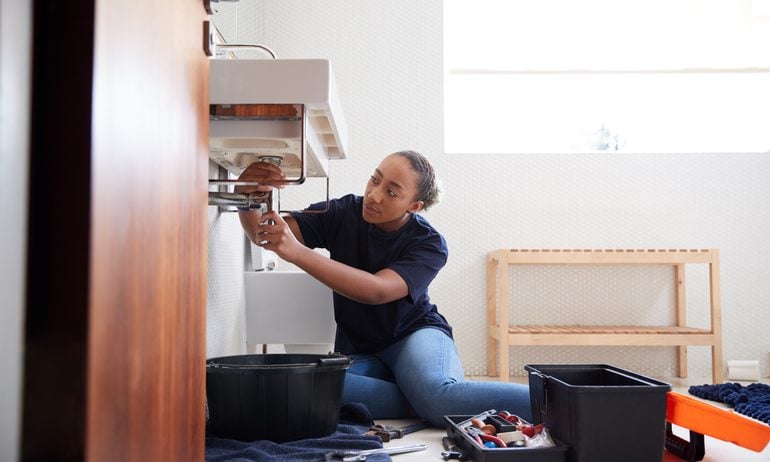What Is Water Backup Coverage, and Do You Need It?
Water backup coverage can pay for damage to your home if a sewer or drain backs up or a sump pump overflows.

Many, or all, of the products featured on this page are from our advertising partners who compensate us when you take certain actions on our website or click to take an action on their website. However, this does not influence our evaluations. Our opinions are our own. Here is a list of our partners and here's how we make money.
A clogged toilet that backs up all over your bathroom. A sump pump breakdown that leaves your basement full of water. These scenarios can turn into a huge headache — and your insurance policy likely won’t pay for the damage. That’s why you might want to consider buying water backup coverage.
What is water backup coverage?
Water backup coverage is an optional type of insurance you can add to a homeowners, condo or renters policy. Because standard home insurance generally won’t cover water damage due to sewer backups or sump pump failure, this add-on coverage — also known as an “endorsement” — can help fill the gap.
As you’re shopping around, you may see other names for this insurance, such as water backup and sump overflow coverage.
What does water backup insurance cover?
Water backup coverage typically pays to repair damage from two scenarios:
Sewers or drains that back up into your home.
Failure or overflow of a sump pump.
The coverage may help with expenses such as buying new personal belongings, replacing damaged carpet or flooring and cleaning up mold.
With this endorsement you can also generally use your policy’s loss of use coverage. This part of your policy pays for additional living expenses if you need to stay somewhere else while your home is cleaned up.
Imagine that the shower in your only bathroom backs up, causing a soggy mess. Your policy may be able to reimburse you for a few nights in a hotel while the pipe is cleared and the damaged flooring is replaced.
Read your policy carefully. This article provides general guidance about what water backup insurance will cover, but the exact wording may vary from one company to another. For example, some companies may specify that damage from a backup is covered only if the water originates from your home.
You’ll usually have a deductible for water backup coverage. A deductible is the amount of a claim you’re responsible for. Your water backup deductible may be the same as your standard policy deductible or a separate amount.
For example, if a sewer backup causes $10,000 worth of damage and you have a $1,000 deductible on your water backup coverage, the insurance company would pay $9,000.
What does water backup insurance not cover?
As with all insurance, water backup coverage has limitations. Below are a few scenarios this endorsement typically won’t cover.
Flooding
Water backup coverage won’t pay for damage related to flooding, including tidal surges, overflowing rivers or lakes, or heavy rain. If you want coverage for these scenarios, you’ll need flood insurance.
Underground water
Water that seeps or flows into your home from underground isn’t covered. For example, this could include a swimming pool that leaks into your foundation or moisture seeping into your home through small cracks.
Negligence
Insurance is designed to cover sudden, unexpected problems, not lack of maintenance. If water damage happens because you’ve neglected to fix an issue that developed over time, your policy generally won’t cover it.
Burst or broken pipes
A standard homeowners, condo or renters policy typically pays for water damage from pipes that suddenly burst. You don’t need a water backup endorsement for this coverage.
Service lines
Say there’s a clog in the sewer line that links your home with your city’s municipal system, and water backs up into your house. Water backup coverage would pay for the damage inside your home. However, if the sewer line itself needed to be replaced, it wouldn’t be covered. Because excavating and replacing the line can get expensive, you may want to consider service line coverage.
Broken sump pump or other appliances
Water backup insurance can pay to clean up damage from a failed sump pump, but it won’t replace the device itself. For that, you could add equipment breakdown coverage to your policy.
If a water heater or other appliance suddenly breaks down, causing water to spew into your home, a standard home insurance policy should cover the damage. But again, it won’t pay to repair or replace the appliance itself unless you’ve added equipment breakdown coverage.
Do you need water backup coverage?
Some insurance agents recommend that all homeowners get water backup coverage. However, it may be particularly worth considering if any of the following risk factors apply to you:
You have a sump pump and/or a basement, especially a finished basement.
You live in an older home with aging pipes.
Your home has nearby trees with roots that could encroach on your plumbing system.
Your community has an older sewer system.
Water and freezing damage is the second most common type of homeowners insurance claim in the U.S., according to 2022 data from the Insurance Information Institute (the most recent data available). The only more common type of claim is wind and hail damage.
Renters don’t need to worry about building damage, but your landlord’s insurance usually won’t pay for your belongings if they’re ruined by a sewer backup. Having water backup coverage can help you replace them and even pay for somewhere else to stay if your apartment is unlivable during cleanup.
How much water backup coverage do you need?
Water backup coverage limits often start around $5,000 per year. The upper limit may go up to the full replacement cost of your house or even more, depending on your insurer. To decide on the right amount of coverage, consider how much you might have to fix or replace.
For example, you might want more coverage if you have a large finished basement with lots of furniture and fixtures. Maybe you have a two-story house with several bathrooms on the second floor — if one of those sinks or toilets backed up, it could potentially damage the floor below, too.
How much does water backup insurance cost?
Depending on where you live and how much coverage you need, water backup insurance can cost $50 to $250 per year. In our sample quotes, we saw rates as low as $39 for $5,000 of coverage.
How to prevent water backups
Following these maintenance tips may help keep water backups from happening in the first place.
Be careful what you put down the drain. Grease, paper products and larger food items can easily clog pipes.
Manage tree roots. Avoid planting anything new near your sewer line, and consider having existing tree roots inspected periodically and cut as necessary.
Install backwater prevention valves. A plumber can put these valves into lower-level drains to keep sewage from coming back into your home.
Flush your plumbing lines regularly. This can help prevent clogs from building up and keep your pipes healthy.
What to do if you have a water backup
Prevent further damage. As soon as you spot the problem, act quickly to keep it from getting worse — for example, by shutting off water or power.
Decide whether to file a claim. If the damage is minimal, submitting a claim may not be worth it. Remember that the insurance company will subtract your deductible from your payout and potentially raise your rates because you’ve filed a claim. You could end up paying more in future premiums than you’d get to repair a minor problem.
Document the damage. If you do decide to file a claim, take photos of damaged belongings, flooring and other items. Reach out to your insurance company promptly so they can assign an adjuster to examine the damage.
Make quick fixes. You won’t want to do major work until your adjuster has done their inspection, but you can do things like getting rid of wet items to keep mold from growing. If sewage is involved, wear protective equipment such as rubber gloves and boots.

